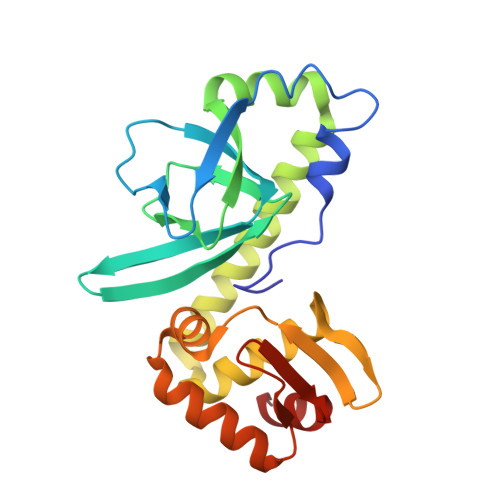Structure-based hypothesis on the activation of the CO-sensing transcription factor CooA.
Borjigin, M., Li, H., Lanz, N.D., Kerby, R.L., Roberts, G.P., Poulos, T.L.(2007) Acta Crystallogr D Biol Crystallogr 63: 282-287
- PubMed: 17327664
- DOI: https://doi.org/10.1107/S0907444906051638
- Primary Citation of Related Structures:
2HKX - PubMed Abstract:
The CooA family of proteins are prokaryotic CO-sensing transcription factors that regulate the expression of genes involved in the utilization of CO as an energy source. They are homodimeric proteins that contain two hemes. Each monomer contains an N-terminal heme-binding domain and a C-terminal DNA-binding domain. Binding of CO to the heme leads to activation by a large reorientation of the DNA-binding domain such that the DNA-binding domain is in position for specific DNA recognition. The crystal structure of CooA from Rhodospirillum rubrum [RrCooA; Lanzilotta et al. (2000), Nature Struct. Biol. 7, 876-880] in the inactive CO-free off-state shows that the N-terminal Pro residue of monomer A coordinates the heme of monomer B and vice versa. It now appears that the CO replaces the Pro ligand and that this change is coupled to the activation process. However, precisely how the replacement of the Pro ligand by CO results in structural changes some 25 A from the CO-binding site remains unknown. Here, the structure of a CooA variant from the thermophilic bacterium Carboxydothermus hydrogenoformans (ChCooA) is reported in which one monomer is fully in the on-state. The N-terminal region that is displaced by CO binding is now positioned between the heme-binding and DNA-binding domains, which requires movement of the N-terminus by approximately 20 A and thus serves as a bridge between the two domains that helps to orient the DNA-binding domain in position for DNA binding.
- Department of Molecular Biology and Biochemistry, University of California, Irvine, California 92697, USA.
Organizational Affiliation:


















